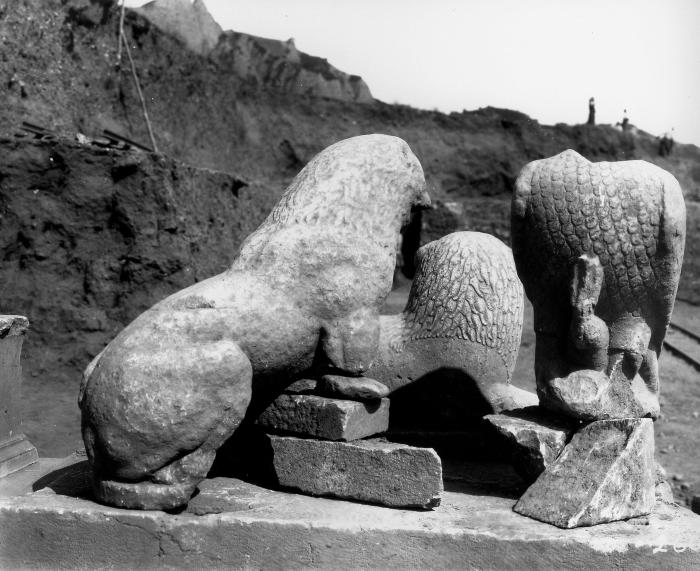Bird of Prey (Eagle?) Holding a Hare, from the Nannas monument
- Date
- Late archaic?, Lydian?
- Museum
- Istanbul, Archaeological Museum, 4032
- Museum Inventory No.
- 4032
- Sardis or Museum Inv. No.
- IAM 4032
- Material
- Marble, Stone
- Object Type
- Sculpture
- Sculpture Type
- Animal
- Site
- Sardis
- Sector
- AT
- Trench
- AT
- Locus
- AT Nannas Monument
- Findspot
- Monument of Nannas (
Cat. 274 Figs. 465-466) with lionsCat. 235 andCat. 236 (Figs. 405-409) "set up without order upon a square pedestal of two steps . . . the eagle had fallen on one side" (Sardis I, 125f.).
- Description
A sitting bird of prey is holding with slightly bent talons a long-eared creature -- hare or rabbit. The wings are folded on the back; they have three tiers of long feathers, while the front part is stylized in small vertical ovals. The chest feathers are rendered as a large scale pattern. The thick feet and talons come out of a bare tarsus. Part of the plain lower body is seen under the wings. The hare has its neck arched, forelegs bent down, and traces of staring eyes.
One may ask whether this is a hawk, sacred to Artemis in Ephesus and Cybele in Lydia, or an eagle. According to D. Howard, Director of Environmental Affairs, Massachusetts Audubon Society, the size and massiveness of the legs and the big feet indicate that the bird is an eagle. She adds that the sea eagle, which has a bare tarsus, still migrates through Western Anatolia to the western Mediterranean, but that the absence of the head and beak makes definite identification impossible (verbal communication).
Since the two lions and the bird need not have been part of one monument, and may, in fact, have been brought together during Roman times, rather than by Nannas in the 4th C. B.C., we cannot automatically assume an archaic date for the bird. Butler recalled Hittite eagles and curiously misread the hare as a "hooded snake." There may be a background of local Anatolian belief but eagle and hare are not uncommon in Greek and Roman art.
- Condition
Marble, worn and weathered gray.
Head of bird and I. foot missing, also parts around base, chipped on back and along wings.
- Dimensions
- H. 0.60; W. 0.40; D. (breast to back) 0.25.
- Comments
- For inscription of Nannas, and reconstruction of the monument by the Romans, cf. Cat. 274 and Sardis R1, 62, 64, 68.
- See Also
- Bibliography
- Published: Sardis I, 125-127, figs. 136-138; Shear, Lion, figs. 3, 4, 7; von Gall, Felsgraber, fig. 4. For Artemis, Cybele, and hawk (mermnos) see R. D. Barnett, Ancient Oriental Influences.
- Author
- NHR



